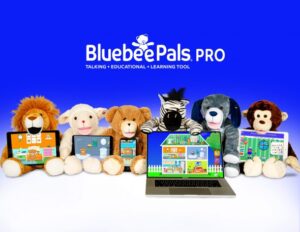
“The term “early math” refers to a broad range of basic concepts such as counting (1, 2, 3); quantity (more, fewer); shapes (circles, squares, triangles); spatial relations (over, under); measurement (tall, short; bigger, smaller); and patterns (red, blue, red, blue). Because children are naturally curious, they explore these concepts as they interact with their environment. Infants begin to learn math before they can sit up. They notice differences in quantity, they compare the shape and size of objects, and they use early math concepts when they play and in other aspects of their daily lives. https://files.eric.ed.gov/fulltext/ED594025.pdf
Why is Early Math Important?
Activities to Foster Development of Early Math Skills:
Bluebee Pals:
practice skills. Paired with reading, storybooks and math apps, Bluebee Pals offer children a special learning friend who makes educational skills practice fun…and
 therefore, more meaningful. By “speaking and singing” the audio in connected apps, a Bluebee Pal adds just the right touch of warmth and humanity to motivate children. Just connect your Bluebee Pal and get started! Reading books, telling stories, and using “math talk” are easy, effective ways to integrate and promote the development of early math and early literacy skills. Using children’s book and math apps provide many ways to teach and reinforce foundational math skills. https://www.bluebeepals.com
therefore, more meaningful. By “speaking and singing” the audio in connected apps, a Bluebee Pal adds just the right touch of warmth and humanity to motivate children. Just connect your Bluebee Pal and get started! Reading books, telling stories, and using “math talk” are easy, effective ways to integrate and promote the development of early math and early literacy skills. Using children’s book and math apps provide many ways to teach and reinforce foundational math skills. https://www.bluebeepals.comMath Book App Examples:
Math App Examples:
Math Games and Activities:
 A great way to “mathematize” children is to use math in the routines of daily life, either as games or as entertaining ways to solve problems. “Make math fun! “Young children work very hard when they’re playing. Play is the perfect learning environment.”https://www.greatschools.org/gk/articles/early-math-equals-future-success/
A great way to “mathematize” children is to use math in the routines of daily life, either as games or as entertaining ways to solve problems. “Make math fun! “Young children work very hard when they’re playing. Play is the perfect learning environment.”https://www.greatschools.org/gk/articles/early-math-equals-future-success/
- Use puzzles, building blocks for stacking and manipulating, board games, and card games. Chutes and Ladders, Pop the Pig, Hi Ho Cherry-O and Candyland are great beginning games. Games with dice and number spinners reinforce counting.
- Use shape-sorters. Talk about each shape—count the sides, describe the colors.
- Count and sort. Gather together a basket of small toys, shells, pebbles or buttons. Count them and sort them based on size, color, or what they do (i.e., all the cars in one pile, all the animals in another).
- What size is it? Notice the sizes of objects in the world around you: That pink pocketbook is the biggest. The blue pocketbook is the smallest. Ask your child to think about his own size relative to other objects (“Do you fit under the table? Under the chair?”).
- You’re cookin’ now! Even young children can help fill, stir, and pour. Through these activities, children learn, quite naturally, to count, measure, add, and estimate.
- Sing songs that rhyme, repeat, or have numbers in them. Songs reinforce patterns (which is a math skill as well). They also are fun ways to practice language and foster social skills like cooperation.
- Use a calendar to talk about the date, the day of the week, and the weather. Calendars reinforce counting, sequences, and patterns.
- The long and the short of it. Cut a few (3–5) pieces of ribbon, yarn or paper in different lengths. Talk about ideas like long and short. With your child, put in order of longest to shortest.
- Pattern play. Have fun with patterns by letting children arrange dry macaroni, chunky beads, different types of dry cereal, or pieces of paper in different patterns or designs.
- Graphing games. As your child nears three and beyond, make a chart where your child can put a sticker each time it rains or each time it is sunny. At the end of a week, you can estimate together which column has more or less stickers, and count how many to be sure.
